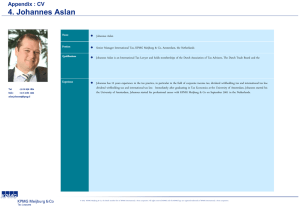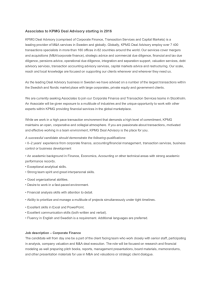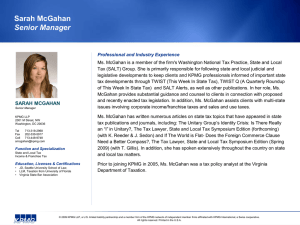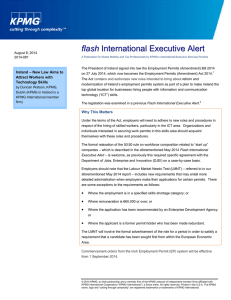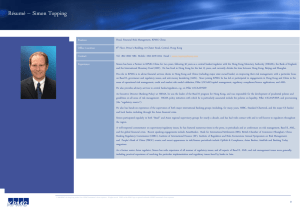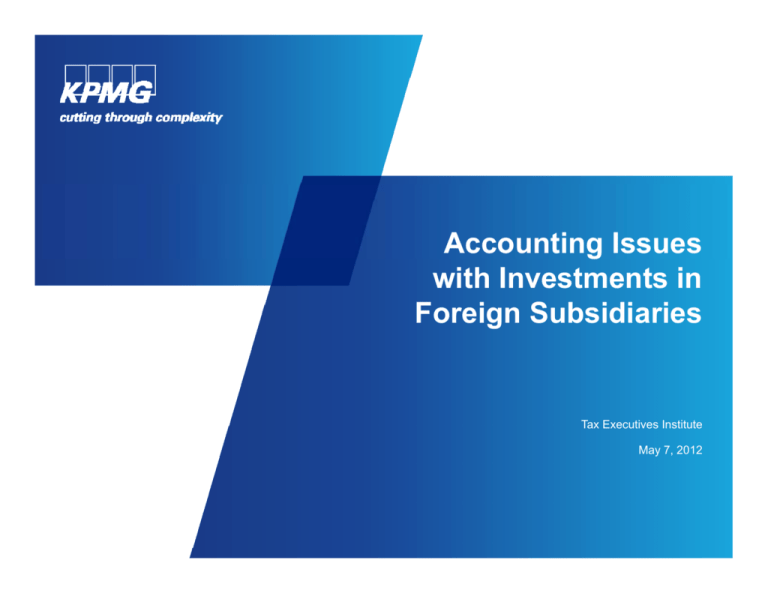
Accounting
g Issues
with Investments in
Foreign Subsidiaries
Tax Executives Institute
May 7, 2012
Notice
ANY TAX ADVICE IN THIS COMMUNICATION IS NOT INTENDED OR WRITTEN BY KPMG
TO BE USED, AND CANNOT BE USED, BY A CLIENT OR ANY OTHER PERSON OR ENTITY
FOR THE PURPOSE OF (i) AVOIDING PENALTIES THAT MAY BE IMPOSED ON ANY
TAXPAYER OR (ii) PROMOTING,
PROMOTING MARKETING OR RECOMMENDING TO ANOTHER PARTY
ANY MATTERS ADDRESSED HEREIN.
You (and your employees, representatives, or agents) may disclose to any and all persons,
t out limitation,
tat o , the
t e tax
ta treatment
t eat e t or
o tax
ta structure,
st uctu e, or
o both,
bot , of
o any
a y transaction
t a sact o desc
described
bed in tthe
e
without
associated materials we provide to you, including, but not limited to, any tax opinions,
memoranda, or other tax analyses contained in those materials.
The information contained herein is of a general nature and based on authorities that are subject
to change. Applicability of the information to specific situations should be determined through
consultation with your tax adviser.
© 2012 KPMG LLP, a Delaware limited liability partnership and the U.S. member firm of the KPMG network of independent
member firms affiliated with KPMG International Cooperative (“KPMG International”), a Swiss entity. All rights reserved.
13169NRL
1
Overview
Inside/outside basis differences
Investment in subsidiaries and equity method investments
Exceptions to income tax recognition
–
Domestic subsidiaries
–
Foreign
g subsidiaries ((formerly
y APB Opinion
p
23 exception)
p
)
© 2012 KPMG LLP, a Delaware limited liability partnership and the U.S. member firm of the KPMG network of independent
member firms affiliated with KPMG International Cooperative (“KPMG International”), a Swiss entity. All rights reserved.
13169NRL
2
Inside basis vs. Outside basis
Inside Basis Differences:
Arise from differences between the financial statement carrying amounts and tax basis of a
subsidiary’s
subsidiary
s (domestic and foreign) assets and liabilities.
Outside Basis Differences:
Arise from differences between the financial statement carrying amount and the tax basis of
the parent company
company’s
s investment in the stock of the subsidiary
© 2012 KPMG LLP, a Delaware limited liability partnership and the U.S. member firm of the KPMG network of independent
member firms affiliated with KPMG International Cooperative (“KPMG International”), a Swiss entity. All rights reserved.
13169NRL
3
Foreign vs. Domestic Subsidiary
Determining whether a subsidiary is Domestic or Foreign
Assessment should be determined at each subsidiary level by reference to the subsidiary’s
immediate parent.
© 2012 KPMG LLP, a Delaware limited liability partnership and the U.S. member firm of the KPMG network of independent
member firms affiliated with KPMG International Cooperative (“KPMG International”), a Swiss entity. All rights reserved.
13169NRL
4
Domestic vs. Foreign Subsidiary Example
U.S. Parent owns German Subsidiary, German Subsidiary owns French Subsidiary 1 and
French Subsidiary 1 owns French Subsidiary 2
Which subsidiaries are domestic and which are foreign?
U.S. Parent
German
Subsidiary
French
Subsidiary 1
French
Subsidiary 2
© 2012 KPMG LLP, a Delaware limited liability partnership and the U.S. member firm of the KPMG network of independent
member firms affiliated with KPMG International Cooperative (“KPMG International”), a Swiss entity. All rights reserved.
13169NRL
5
Investments in domestic subsidiaries
No taxable temporary difference should be recorded if:
–
Law provides a means by which the subsidiary may be recovered tax-free, and
–
The company expects it will ultimately use that means
If less than requisite ownership percentage for tax-free recovery, potential to anticipate
acquisition of additional interest
–
Parent company expects to acquire more shares
–
Acquisition would not result in a significant cost
–
If no tax
tax-free
free options exist due to current ownership,
ownership assess intent with respect to timing
of settlement of minority interest
© 2012 KPMG LLP, a Delaware limited liability partnership and the U.S. member firm of the KPMG network of independent
member firms affiliated with KPMG International Cooperative (“KPMG International”), a Swiss entity. All rights reserved.
13169NRL
6
Investments in foreign subsidiaries
Taxable outside basis differences
Outside basis differences result from:
–
Undistributed earnings
–
Accumulated subsidiary losses
–
Foreign currency translation gains and losses included in equity
–
Business combinations
–
Gains recognized on the issuance of stock by the subsidiary
Will result in future taxable or deductible amounts when:
–
Dividends paid
–
Stock of the subsidiary is sold
–
Subsidiaryy is liquidated
q
–
Subsidiary is merged into the parent company
© 2012 KPMG LLP, a Delaware limited liability partnership and the U.S. member firm of the KPMG network of independent
member firms affiliated with KPMG International Cooperative (“KPMG International”), a Swiss entity. All rights reserved.
13169NRL
7
Investments in foreign subsidiaries
Outside basis differences
ASC 740-30 establishes a presumption that all undistributed earnings of a subsidiary will be
transferred to the parent company
Exception (FASB ASC 740-30-25-17
740 30 25 17 and 25-18a)
25 18a) (APB Opinion 23)
–
Applies to excess of financial carrying amount over the tax basis of investment
–
Not applicable to inside basis differences
–
Applicable only to foreign subsidiaries and foreign corporate joint ventures
–
Not applicable to investments accounted for under the equity method unless the investee
meets the definition of foreign corporate joint venture
© 2012 KPMG LLP, a Delaware limited liability partnership and the U.S. member firm of the KPMG network of independent
member firms affiliated with KPMG International Cooperative (“KPMG International”), a Swiss entity. All rights reserved.
13169NRL
8
Investments in foreign subsidiaries
Outside basis differences (continued)
Criteria to apply
–
Plan to reinvest earnings indefinitely
–
Intent and ability to permanently reinvest
–
Remitted in a tax free manner
–
Will not reverse in foreseeable future
Variable Interest Entities (VIEs)
© 2012 KPMG LLP, a Delaware limited liability partnership and the U.S. member firm of the KPMG network of independent
member firms affiliated with KPMG International Cooperative (“KPMG International”), a Swiss entity. All rights reserved.
13169NRL
9
ASC 740-30-25-17 considerations
Policy may differ by subsidiary
Treatment of Subpart F income
Continued reinvestment of prior earnings when future earnings may be repatriated
Impact of fixed dividend payments
Foreign
g branches
Not limited to U.S. jurisdiction
Plans to sell subsidiary
© 2012 KPMG LLP, a Delaware limited liability partnership and the U.S. member firm of the KPMG network of independent
member firms affiliated with KPMG International Cooperative (“KPMG International”), a Swiss entity. All rights reserved.
13169NRL
10
ASC 740-30-25-17 considerations
Supporting indefinite reinvestment
In order to support an indefinite reinvestment of earnings, example documentation
may include:
–
Significant inter-company
inter company or third party debt which would require cash
–
Details of plant expansion to be undertaken
–
Acquisitions planned
–
Documentation of advertising or promotion campaign planned
–
Providing funding for other group members
–
Debt covenants restricting dividend payments
–
Additional borrowing plans
–
Past activities of the entity
The company’s supporting assertions for indefinite reinvestment of earnings should not be
inconsistent with other financial statement assertions
© 2012 KPMG LLP, a Delaware limited liability partnership and the U.S. member firm of the KPMG network of independent
member firms affiliated with KPMG International Cooperative (“KPMG International”), a Swiss entity. All rights reserved.
13169NRL
11
Investments in subsidiaries – Foreign or domestic
Excess tax basis
Excess tax basis related to outside basis difference for both domestic and foreign subsidiaries
–
–
ASC 740-30-25
No deferred tax asset unless basis difference reverses in foreseeable future
Generally recognize deferred tax liabilities
Foreseeable future g
generally
y believed to be within one yyear
ASC 360-10-45 – held for sale criteria useful in this context
– Existing committed plan
– Ability to immediately execute the transaction
– Active program to locate a buyer
– Transaction is p
probable and likely
y to be completed
p
within a yyear
– Marketing the entity at a reasonable price
– Unlikely that significant changes to the plan will be made
© 2012 KPMG LLP, a Delaware limited liability partnership and the U.S. member firm of the KPMG network of independent
member firms affiliated with KPMG International Cooperative (“KPMG International”), a Swiss entity. All rights reserved.
13169NRL
12
Equity method investments
Outside basis differences
Often give rise to temporary differences because investments are accounted for under cost
method for tax purposes
Differences measured at investor level
Exceptions to recognition of deferred tax liabilities and deferred tax assets generally do
not apply
Specific exceptions to recognition are:
–
Taxable basis differences in foreign enterprises that arose when equity investment was a
consolidated subsidiary
–
I
Investment
t
t in
i certain
t i foreign
f i corporate
t joint
j i t ventures
t
–
Undistributed pre-1993 earnings of a domestic corporate venture
© 2012 KPMG LLP, a Delaware limited liability partnership and the U.S. member firm of the KPMG network of independent
member firms affiliated with KPMG International Cooperative (“KPMG International”), a Swiss entity. All rights reserved.
13169NRL
13
Outside basis differences—summary
Taxable temp difference
Domestic
Subsidiary
Corporate joint venture
Other equity methods
VIEs
Foreign
Tax free recovery and
pre-1993 exception –
ASC 740-30-25-18(b)
Essentially permanent in
duration exception – ASC
740-30-25-18(a)
Deductible
Temp difference
DTA prohibited,
prohibited unless
“apparent” test met
(ASC 740-30-25-9)
Same rules as a subsidiary
General rules of ASC 740; no exceptions
Same rules as a subsidiary (control of how and when earnings are
distributed must be considered)
© 2012 KPMG LLP, a Delaware limited liability partnership and the U.S. member firm of the KPMG network of independent
member firms affiliated with KPMG International Cooperative (“KPMG International”), a Swiss entity. All rights reserved.
13169NRL
14
Intraperiod allocation
The deferred taxes recognized on temporary differences resulting from translation
adjustments are charged or credited to the cumulative translation adjustment component
of other comprehensive income as such temporary differences arise.
ASC paragraphs 740-20-55-18 through 55-24 include an example of the recognition of
deferred taxes on unremitted earnings and translation adjustments. In that example,
deferred taxes for both the unremitted earnings and the translation adjustments are
measured
easu ed us
using
g a net
et tax
ta rate
ate that
t at reflects
e ects foreign
o e g ta
tax ccredits.
ed ts
It may also be acceptable to allocate foreign tax credits only to the unremitted earnings and
to use the gross rate for measuring deferred taxes on the translation adjustments.
© 2012 KPMG LLP, a Delaware limited liability partnership and the U.S. member firm of the KPMG network of independent
member firms affiliated with KPMG International Cooperative (“KPMG International”), a Swiss entity. All rights reserved.
13169NRL
15
Example
On January 1, 20X2, Parent Company, a U.S. company, acquired all of the common stock
of Company ABC Corp. for $1,000 in cash. ABC operates in a foreign tax jurisdiction;
its functional currency is the local foreign currency.
Parent Company’s tax basis of the investment in the stock of ABC was $1,000 on January 1,
20X2. On January 1, 20X2, the exchange rate was FC 1 = U.S. $1. The average exchange
rate for the year ended December 31, 20X2 and the exchange rate at December 31, 20X2
were
e e FC
C1=U
U.S.
S $
$1.10
0a
and
d FC
C1=U
U.S.
S $
$1.15,
5, respectively.
espect e y
© 2012 KPMG LLP, a Delaware limited liability partnership and the U.S. member firm of the KPMG network of independent
member firms affiliated with KPMG International Cooperative (“KPMG International”), a Swiss entity. All rights reserved.
13169NRL
16
Intraperiod allocation
A summary of Company FS’s balance sheet at December 31, 20X2 in the foreign currency
and in U.S. dollars is presented below:
FC
Assets
$
2,000
2,300
800
920
1,000
1,000
200
220
0
160
Total equity
1,200
1,380
Total liabilities and equity
2,000
2,300
Liabilities
St kh ld ’ equity:
Stockholders’
it
Common stock
Retained earnings
Cumulative translation adjustment
© 2012 KPMG LLP, a Delaware limited liability partnership and the U.S. member firm of the KPMG network of independent
member firms affiliated with KPMG International Cooperative (“KPMG International”), a Swiss entity. All rights reserved.
13169NRL
17
Intraperiod allocation (continued)
At December 31, 20X2, there is a taxable temporary difference in the U.S. tax jurisdiction of
$380 between Parent Company’s financial statement carrying amount of $1,380 and tax basis
of $1,000 of the investment in the stock of ABC due to an increase in assets represented by
undistributed earnings of $220 and the effect of the translation adjustment of $160
$160.
If the indefinite reversal criterion does not apply, the deferred tax liability on the basis
difference would be recognized. Assume Parent Company has a 40% U.S. tax rate and ABC
has
as generated
ge e ated $20
$ 0 of
o foreign
o e g tax.
ta Parent
a e t company
co pa y would
ou d make
a eo
one
eo
of tthe
e following
o o ge
entries
t es
to recognize the deferred tax liability on its outside basis difference, based on company policy.
© 2012 KPMG LLP, a Delaware limited liability partnership and the U.S. member firm of the KPMG network of independent
member firms affiliated with KPMG International Cooperative (“KPMG International”), a Swiss entity. All rights reserved.
13169NRL
18
Intraperiod allocation (continued)
ASC 740-20-55-18 approach:
Income tax expense ($220 x 36.84% (A))
81
Cumulative translation adjustment ($160
$
x 36.84%)
59
–
Deferred tax liability (($380+20) x 40% – $20)
140
pp
With-and-without approach:
Income tax expense (($220+20) x 40% – $20)
76
Cumulative translation adjustment (residual)
64
–
Deferred tax liability (($380+20) x 40% – $20)
140
(A) Represents the effective rate net of foreign tax credits. Computed as total tax of $132 divided by the outside basis difference of $380.
© 2012 KPMG LLP, a Delaware limited liability partnership and the U.S. member firm of the KPMG network of independent
member firms affiliated with KPMG International Cooperative (“KPMG International”), a Swiss entity. All rights reserved.
13169NRL
19
Questions?
Ashby Corum
Partner
Washington National Tax
acorum@kpmg.com
(313) 230-3361
© 2012 KPMG LLP, a Delaware limited liability partnership and the U.S. member firm of the KPMG network of independent
member firms affiliated with KPMG International Cooperative (“KPMG International”), a Swiss entity. All rights reserved.
13169NRL
20
© 2012 KPMG LLP, a Delaware limited liability
partnership and the U.S. member firm of the KPMG
network of independent member firms affiliated with
KPMG International
I t
ti
l Cooperative
C
ti (“KPMG
International”), a Swiss entity. All rights reserved.
13169NRL
The KPMG name, logo and “cutting through
co p e ty a
complexity”
are
e registered
eg ste ed ttrademarks
ade a s o
or ttrademarks
ade a s
of KPMG International.




